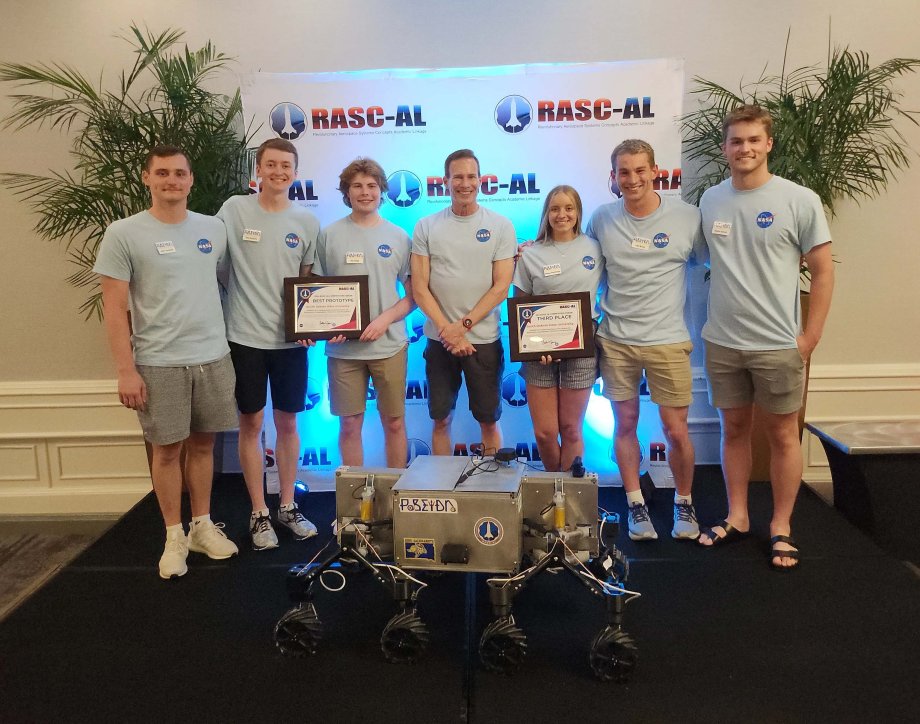SDSU takes third at NASA’s RASC-AL contest

Article by Dave Graves and picture from SDSU.
Competing against the best and the brightest, a South Dakota State University engineering team finished third overall in a NASA contest and again was awarded for building the best prototype.
The SDSU students were one of 14 teams selected from 75 higher education entries to compete in the finals of the Revolutionary Aerospace Systems Concepts – Academic Linkage (RASC-AL) competition June 10-12 in Cocoa Beach, Florida. It is the second straight year for an SDSU team to qualify for the finals.
Traditionally, NASA only awards the top two entries in the overall results. In fact, this is only the third time in the contest’s 23-year history that third place has been recognized.
Liam Murray, a mechanical engineering graduate student adviser for the team, said, “The points were so close between Maryland and us that it came down to a judge’s vote. They (the judges) knew we did so well and invented a new suspension system, so they wanted to make sure we were properly recognized.”
View full article and protype video here!
NASA names finalists in four categories. SDSU was competing in the large-scale lunar crater prospector category.
The overall champion was from Virginia Tech, competing in the AI-powered self-replicating probes — an evolutionary approach. Finishing second overall was the University of Maryland, competing in the large-scale lunar crater prospector category — the same category as SDSU.
The job of prospector contestants was to design and build a rover that could explore rugged and permanently shadowed lunar south pole craters searching for water, ice and other volatiles.
The SDSU team designed and built a rover prototype, which is a little smaller than a go-cart. It uses lidar and high-tech cameras to measure ground composition of lunar craters with the aim of locating ground ice.
It’s NASA’s long-term goal to be able to mine that ground ice and extract water, which could be used for drinking and possibly for creating rocket fuel.
SDSU finishes ahead of MIT, Stanford
While that’s a long way in the future, Murray is excited about the short-term future for the five mechanical engineering majors who made up SDSU’s RASC-AL team. Three graduated in May and are returning to SDSU for a master’s degree in mechanical engineering with an aerospace engineering emphasis.
Two just completed their sophomore years and will be back to help steer another lunar project.
An excited Murray said, “We really felt like the people’s champion. Everyone was so kind and showing their appreciation for our in-depth effort in our project, including the judges.”
Among the 14 finalists were the University of Texas, Stanford University and Massachusetts Institute of Technology.
A fitting reward
The SDSU team gave a 25-minute presentation to a panel of NASA and industry experts and then faced 25 minutes of questions on June 10. The following days they listened to other presentations, participated in poster sessions and toured nearby Kennedy Space Center before attending the June 12 awards dinner.
Murray said hearing SDSU’s name called for third place overall and for having the best prototype was a tremendous reward for the hundreds of hours the team spent to get to that point.
“I was humbled and proud of our accomplishments. I believe our greatest achievement was inspiring this group of future leaders to pursue higher education at SDSU. By recognizing the benefits and potential of a master’s or Ph.D., they will be better equipped to shape the future of space exploration,” Murray said.
 National Science Foundation RII Track-1 Project:Expanding Research, Education and Innovation in South Dakota
National Science Foundation RII Track-1 Project:Expanding Research, Education and Innovation in South Dakota